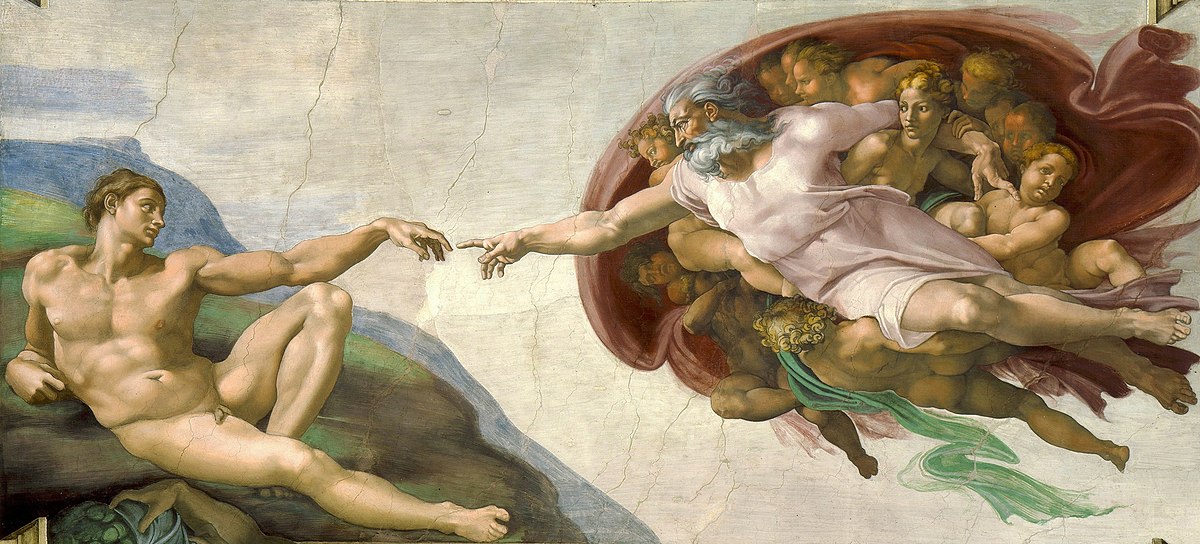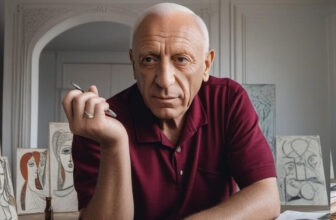
Why is The Creation of Adam controversial?
The Creation of Adam, painted by Michelangelo as part of the Sistine Chapel ceiling between 1508 and 1512, is one of the most iconic works of art in Western history. This fresco, depicting God reaching out to touch Adam’s finger, giving him life, is celebrated for its artistic brilliance, intricate symbolism, and theological depth. However, it has also been a source of controversy, sparking debates on religious, artistic, cultural, and even scientific grounds. This discussion delves into the reasons why The Creation of Adam is controversial, exploring its theological interpretations, artistic innovations, cultural significance, and modern criticisms.
1. Theological Interpretations and Challenges
A. The Representation of God
One of the most contentious aspects of The Creation of Adam is Michelangelo’s depiction of God as an anthropomorphic figure. In the fresco, God is portrayed as an elderly man with a flowing white beard, muscular physique, and a majestic robe. This representation aligns with Renaissance ideals of humanism, where the divine is rendered in human terms. However, this depiction has faced criticism from certain theological perspectives that argue against visualizing God in human form.
In many Judeo-Christian traditions, God is considered transcendent and beyond human comprehension. The Second Commandment, which prohibits the making of graven images, has often been interpreted as forbidding physical depictions of God. Michelangelo’s portrayal of God as a human being, albeit a glorified one, challenges these theological principles and raises questions about the appropriateness of such imagery in religious art.
B. The Narrative Ambiguity
The Creation of Adam has also sparked debate due to its interpretive openness. While the fresco is traditionally understood as depicting the moment God imbues Adam with life, some interpretations suggest alternative meanings. For example, the close proximity of God and Adam’s hands, without them actually touching, has been read as emphasizing the distance and tension between humanity and divinity. This ambiguity allows for diverse interpretations but also creates theological discomfort among those who seek a definitive narrative in religious art.
Moreover, the presence of figures surrounding God, particularly the figure often identified as Eve or the Virgin Mary, has led to conflicting interpretations. Some argue that these figures symbolize humanity’s collective potential, while others see them as a prefiguration of the New Testament. This multiplicity of meanings has fueled debates over the fresco’s theological accuracy and intent.
2. Artistic Innovations and Criticism
A. The Human Body as Divine
Michelangelo’s mastery of human anatomy is evident in The Creation of Adam. Both God and Adam are depicted with idealized physiques, showcasing Michelangelo’s deep understanding of the human form. While this artistic choice reflects the Renaissance emphasis on humanism and the celebration of human potential, it has also drawn criticism for elevating the human body to divine status.
Some critics argue that the emphasis on physical perfection detracts from the spiritual essence of the scene. By portraying both God and Adam as muscular and physically idealized, Michelangelo blurs the line between the divine and the earthly, potentially undermining the spiritual message of the fresco.
B. The Brain Controversy
A modern controversy surrounding The Creation of Adam is the hypothesis that Michelangelo embedded an anatomical depiction of the human brain in the fresco. Researchers have pointed out that the shape of the drapery and figures surrounding God closely resembles a cross-section of the human brain. This interpretation suggests that Michelangelo, who had studied anatomy extensively, may have intentionally included this detail to symbolize the divine origin of human intellect.
While this theory has been celebrated as evidence of Michelangelo’s genius, it has also been criticized for projecting modern scientific concepts onto a Renaissance artwork. Skeptics argue that the resemblance could be coincidental and that interpreting the fresco through a contemporary lens risks distorting its original meaning and intent.
3. Cultural and Historical Context
A. Renaissance Humanism
The Creation of Adam epitomizes the Renaissance ideals of humanism, which emphasized the dignity, potential, and centrality of human beings. By portraying Adam as a noble and majestic figure, Michelangelo elevates humanity to a position of great importance in the divine order. This perspective aligns with the Renaissance belief in the harmony between human achievement and divine purpose.
However, this humanistic emphasis has been controversial, particularly among those who view it as diminishing the supremacy of God. Critics argue that the fresco’s focus on the human form and human potential risks overshadowing the divine aspect of creation, shifting the balance of power and reverence in the narrative.
B. The Patronage of the Church
The Creation of Adam was commissioned by Pope Julius II as part of the larger Sistine Chapel ceiling project. This patronage highlights the complex relationship between art, religion, and politics during the Renaissance. While the fresco is a testament to the Church’s support for the arts, it also reflects the Church’s desire to assert its power and influence through monumental works of art.
This dynamic has led to criticisms of The Creation of Adam as a product of political propaganda rather than purely spiritual inspiration. Some argue that the fresco’s grandeur and artistic innovation serve more to glorify the Church and its patrons than to convey a humble and devout message of creation.
4. Modern Criticisms and Interpretations
A. Feminist Critiques
In recent decades, The Creation of Adam has been scrutinized through a feminist lens. Critics have pointed out that the fresco’s focus on the male figures of God and Adam marginalizes the role of women in the creation narrative. While a female figure is present among the beings surrounding God, her identity and significance remain ambiguous and secondary.
Feminist interpretations have also questioned the absence of a more prominent representation of Eve, who plays a crucial role in the biblical creation story. This exclusion reflects broader patterns of gender bias in religious art and theology, sparking debates about the ways in which such works perpetuate patriarchal narratives.
B. Secular and Scientific Perspectives
The Creation of Adam has also faced criticism from secular and scientific perspectives. Some view the fresco as emblematic of the tension between religious and scientific worldviews. The depiction of God as a bearded man reaching out to Adam can be seen as a simplistic and anthropocentric interpretation of creation, clashing with modern scientific understandings of the origins of life and the universe.
Additionally, the brain hypothesis mentioned earlier has been interpreted by some as a critique of religious dogma. If Michelangelo indeed intended to depict the human brain, it could be seen as a subtle assertion of the primacy of reason and intellect over blind faith. This interpretation aligns with the Renaissance spirit of inquiry but also fuels controversy by challenging traditional religious narratives.
C. Commercialization and Popular Culture
In contemporary times, The Creation of Adam has been widely reproduced and commercialized, appearing on everything from posters and T-shirts to advertising campaigns. While this widespread popularity attests to the fresco’s enduring appeal, it has also sparked criticism for trivializing and commodifying a profound religious and artistic masterpiece.
The use of The Creation of Adam in popular culture often strips it of its original context and meaning, reducing it to a visual icon rather than a subject of deep contemplation. This trend has raised concerns about the loss of reverence for the artwork and its underlying spiritual and cultural significance.
The Creation of Adam remains a masterpiece that continues to captivate and inspire audiences worldwide. Its controversies, spanning theological, artistic, cultural, and modern perspectives, underscore its complexity and enduring relevance. While debates over its interpretation and significance may never be fully resolved, these discussions enrich our understanding of the fresco and its place in the history of art and thought.
Michelangelo’s work challenges viewers to grapple with profound questions about the nature of divinity, humanity, and creation. Its controversies reflect the dynamic interplay between tradition and innovation, faith and reason, and individual and collective meaning. Ultimately, The Creation of Adam invites us to engage with its mysteries and marvel at its beauty, even as we wrestle with its ambiguities and implications.





